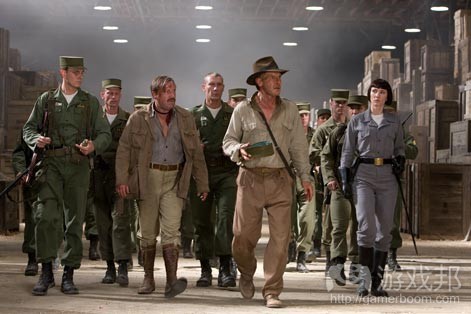游戏剧情设计小技巧之拯救台词篇
作者:Guy Hasson
戏剧在台词及其作用方面的理论的发展史已经不止2500年了。在这里,我们对戏剧台词理论的精华内容进行一次速成学习,包括动作、向量式样动作(这里的“向量”是指促使角色去做某事的目的或企图)及角色说话时的身体动作的处理方法。这一次,我们将借用戏剧的理论来谈谈:在台词文本很失败的情况下,如何保全场景。
除此之外,还有一些电影手法也可以助场景一臂之力。如果你能在摄影机上动动脑子,主要是发挥想像,一定可以让观众陶醉其中,而忽略了影片到底在讲什么。关于这占有不少电影理论可供参考。在此我们就不涵盖这部分知识了。我们现在要谈技巧很可能是你前所未闻的。
技巧1:让角色做点什么,别闲着。
在戏剧中,让角色忙碌的事都算是“事情”,如打包行李、整理房间、接过从别人手上传来的盐等等。
拯救糟糕对话的典型方法就是保证角色在说台词时手头上忙着做其他事。一方面,可以是一些私事(如打包行李、叠衣服),不过我有更高明的办法,就是让场景中的所有人都忙碌于一件事,给这个场面本身编织一个小插曲。
例如:游戏中,有一帮坏家伙正准备去打劫。他们的谈话中会透露不少信息,好让玩家对这些家伙的来头和个性有一个基本的认识。但这部分对白文本实在是不行,你也没有办法调整。
我推荐的办法之一是:这一幕开始后,大家七手八脚地分发武器,这其中有一件武器吸引了众人的目光。当坏蛋们说话时,这件武器就从一个人手上传到另一个人手上。每经手一个人,这个人就打量一下它的样子或者观察把持它的方法等,另一个人就忙着把枪递给他。
对白开始时,正是这件芝麻般大小的事,牢牢地锁住了玩家的视线。这个动作与台词文本并无关系,与所构建的小场景倒是有些关系。
相同的场景,还有另一个方法,就是在分发武器时,让一个家伙取出一件武器,然后扫视每一个人,此时大家正在七嘴八舌地说话。每个人都很焦躁不安,可以在展示对白时产生一些有趣的相互作用和反应。
记住,要以一些出乎料或至少有点意思的事作为这个场景和小插曲的收尾。例如,那个拿着枪的家伙突然就把枪弄走火了,一颗子弹飞出来擦伤了另一个家伙的脸。被擦伤的家伙很恼火,但没有发生伤亡事件。
技巧2:设置一点台词之外的悬念。
电影《夺宝奇兵》(我忘了是第一部还是第二部了)当中有一个经典例子。主角Indie正在和其他人有一搭没一搭地闲聊。对话的信息是很重要的,但本身没有什么精彩的“行动”(游戏邦注:这里的“行动”是指出现在某个场景的角色为了达到到某个目的而做出的每一步举动)。导演斯皮尔伯格是怎么做的?他就设置了一点无关台词的悬念。
Indie和其他几个家伙正在吃枣。其中一个人中毒了。导演把观众的目光引向他们吃的枣,使我们产生一个疑问:Indie会吃吗?Indie把玩着枣,最后把枣抛向空中,再用嘴接住它(这是我回想出来的,如果不太准确就见谅了)。这时候,观众死死地盯着屏幕,迫不及待地想知道主角的命运如何。
这部分对整个剧本并不是必要的,但为了拯救让人抓狂的台词,就必须表现出来。
你可以创意地处理崩坏的台词。
希望我们这个借用戏剧台词理论来提升游戏对白的速成课能让大家有所收获。下次我们将继续探讨台词的问题,但我们将从进阶篇转向基本功,将涉及一些台词的基本禁忌。(本文为游戏邦/gamerboom.com编译,如需转载请联系:游戏邦)
Story Design Tips: How To Save Bad Dialogue
by Guy Hasson
Over the last three weeks, we’ve covered dialogue theory from a different viewpoint. The theater has been developing theory about dialogue and how it works for the last 2,500 years, and we’ve been getting a crash course in its highlights. We covered actions, treating actions as vectors, and what to physically do with the characters when they talk. This time we’re going to borrow another theory from the theater: how to save a scene when the text is bad.
Other than these, there are also cinematic ways that can save a scene. If you do something fascinating with the camera, basically anything fancy, you’re likely to hold your audience rapt, almost no matter what is being said. There’s a lot of cinematic theory about this. We’re not going to cover it. We’re going to stick to the methods you’re more likely not to have heard of.
Tip #1: Use ‘business’
‘Business’ in the theater is basically anything a character does that busies that character: packing a suitcase, rearranging a room, trying to get the salt as it passes from one person to the next.
A classic way to ‘save’ bad dialogue is to make sure that the characters busy themselves with business as they say the text. On the one hand, you can have it be something personal (like packing a suitcase or folding laundry), but there’s a more interesting solution, and that is creating business which busies all the characters in the scenes, and knitting a teeny, tiny story within the scene itself.
For example: Say you’ve got a bunch of bad guys about to start a heist in your game. There’s a lot of information you need them to say, so the player will get the back story as well as the personality of the characters. But the text is bad and you haven’t found a way to fix it.
Here’s one solution out of many: As the scene starts and the weapons are being handed out, there’s one particular weapon that catches everyone’s eyes. As they’re speaking, they’re passing it from one person to the next, and each time a person holds it, tries to look through its sites, tries to see how it handles, etc., someone is trying to take the gun away for him.
It’s such a small thing, but it keeps the players’ eyes and attention peeled, as the dialogue is being performed. The actions in this case have less to do with the text in the dialogue and more with the little scene you’ve just constructed.
Another solution to the same scene is to have one guy take out a weapon as weapons are handed out, and to look at each and every person talking through the site. It makes everyone nervous, fidgety, and could make for some interesting interactions and reactions as the dialogue is being said.
Remember to close the scene by also closing your little story with something surprising, or at least interesting. For example, the guy holding the gun could accidentally let a bullet fly, and graze the cheek of one of the bad guys. Anger ensues, but no one is harmed.
Tip #2: Find a grain of suspense regardless of dialogue
There’s a classic example for this in an Indiana Jones movie (I never remember if it’s the first or the second one). Indie, the hero, is having a rather boring conversation with some other guy. The information is important, but there are no interesting ‘actions’ (see definition) there. What did Spielberg do? He found a grain of suspense regardless of the dialogue.
Indie and the other guy are eating dates, and one of them has been poisoned. Spielberg focuses our attention solely on what happens with the date: will Indy eat it or won’t he? Indy plays with the date, and eventually throws it in the air in order to have it land in his mouth (I recall the scene from memory, so please excuse me if it’s inaccurate). All this while, the audience is riveted to the screen because it needs to know if his hero will die or not.
This part wasn’t really necessary for the plot. It was necessary to save the dialogue.
You can save bad dialogue just as creatively.
I hope you’ve enjoyed this crash course in advanced dialogue theory borrowed from the theater. Next time we’re still going to cover dialogue, but we’re going to move from the advanced to the basics. We’re going to cover some basic don’ts.(source:gamasutra)
下一篇:阐述衡量游戏设计师价值的3大标准










































